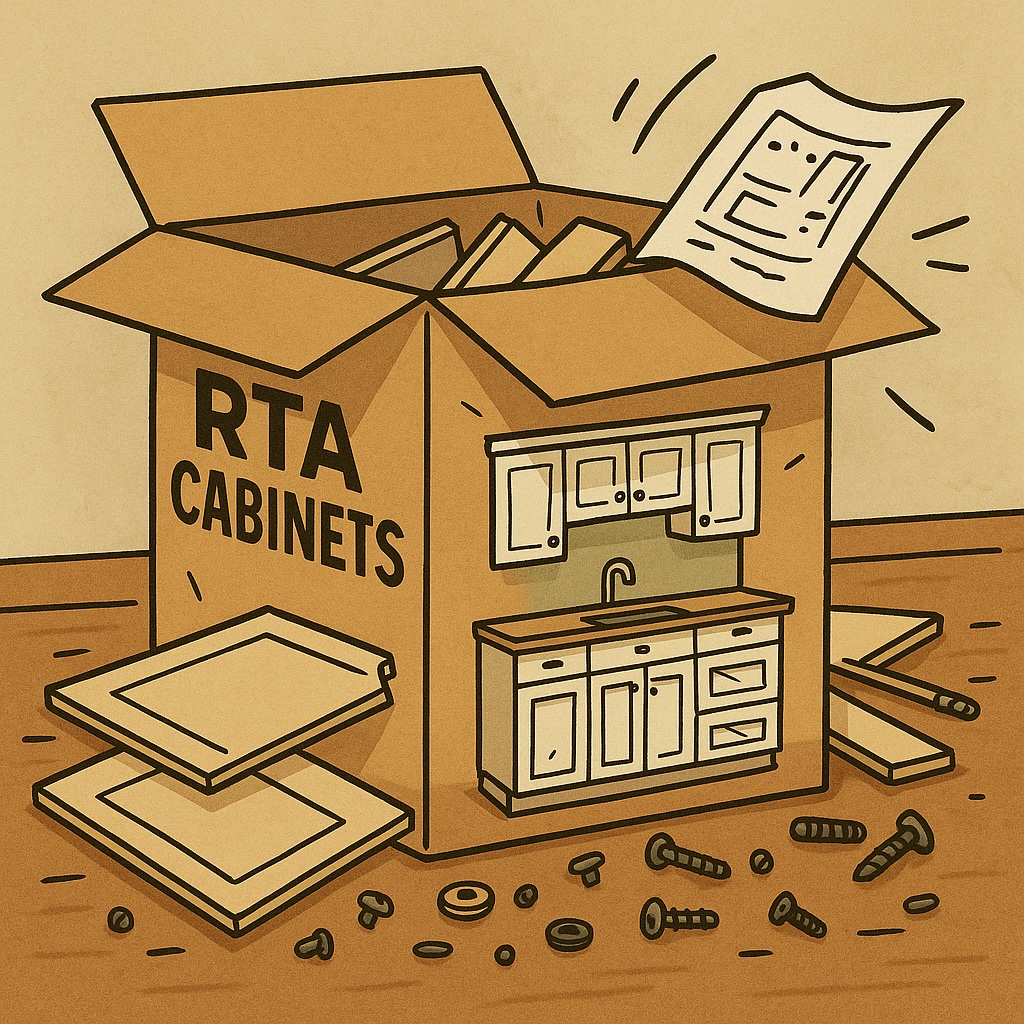
RTA (Ready-to-Assemble) cabinets are everywhere online. They’re marketed with glossy photos, trendy finishes, and a price point that makes them tempting for budget-conscious remodels. But here’s the problem: those savings come with hidden costs.
By contrast, semi-custom cabinetry delivers many of the same “gold standard” qualities you’d expect from full custom cabinets — strong construction, durable finishes, tailored sizing, and professional factory assembly — all at a more accessible price.
Before you get caught in the “flat-pack trap,” let’s compare what you really get with RTA versus semi-custom.
1. Construction & Joinery
Semi-Custom / Custom:
Factory-built using dowels, pocket screws, dado joints, and adhesives pressed under controlled conditions. Every cabinet box leaves the factory square, strong, and ready to last for decades.
RTA:
Flat-packed and designed to be assembled with cam locks, screws, or small dowels at home. These “knock-down” connections loosen under stress and rely heavily on who does the assembly.
Why it matters: Semi-custom boxes stay square and solid. RTA boxes can sag, wobble, or come apart after just a few years of use.
2. Materials & Substrates
Semi-Custom / Custom:
Options for all-plywood boxes, thicker back panels, and hardwood frames. Designed to resist moisture, hold screws tightly, and withstand daily wear.
RTA:
Often made with thinner particleboard or MDF to keep shipping weight down. These materials swell with moisture and chip easily around stress points like hinge screws.
Why it matters: Semi-custom cabinets offer furniture-grade durability. RTA cabinets trade long-term performance for shipping efficiency.
3. Finishing Process
Semi-Custom / Custom:
Multi-step finishes, often catalyzed conversion varnish or baked-on coatings, applied in professional spray booths. These finishes resist scratches, fading, and moisture, while creating depth of color that lasts.
RTA:
Mass-production finishes sprayed or rolled quickly, often overseas. Coatings are thinner and less protective, leading to chips, peeling edges, and uneven color.
Why it matters: Semi-custom finishes protect your investment for decades. RTA finishes often show wear within a few years.
4. Sizing & Flexibility
Semi-Custom / Custom:
Available in flexible increments with modifications like deeper bases, taller wall cabinets, and custom moldings. This allows kitchens to be designed with efficiency and aesthetics in mind.
RTA:
Offered only in stock sizes, usually in 3-inch increments. This leads to awkward gaps, extra filler strips, and layouts that feel pieced together.
Why it matters: Semi-custom maximizes storage and creates a polished, seamless look. RTA forces compromises in both function and style.
5. Quality Control
Semi-Custom / Custom:
Cabinets are built and inspected by trained professionals in a factory setting. Installers receive square, consistent cabinets that go together smoothly.
RTA:
Quality control is outsourced to the homeowner or installer during assembly. Even small mistakes (a misaligned hinge, skipped glue, or overtightened screw) can compromise the entire cabinet.
Why it matters: Semi-custom guarantees consistency. With RTA, the outcome varies wildly depending on who holds the screwdriver.
The Bigger Picture: Built for Living, Not Shipping
When you step back, the difference is clear:
- Semi-Custom: Built to the same standards as custom cabinetry in construction, finishes, and sizing flexibility. Designed for living in your kitchen for decades.
- RTA: Built for flat-pack shipping, lower costs, and DIY assembly. Designed to look good in ads, but often disappointing in daily life.
Conclusion: Invest Where It Matters
Semi-custom cabinetry gives you the best of both worlds — the craftsmanship and durability of custom cabinets, paired with the accessibility of more flexible price points. You get finishes that last, boxes that stay strong, and layouts that truly fit your home.
RTA cabinets, on the other hand, may look appealing at checkout but too often reveal their flaws once installed — in crooked doors, worn finishes, and short lifespans.
At Belle Design Collective, we help homeowners avoid the flat-pack compromise. Our team will guide you toward cabinetry that balances strength, beauty, and smart design — so your kitchen investment pays off for decades, not just a few years.
Written by Emily Wold
Owner of Belle Design Collective, San Diego & Seattle
Ready to modernize your kitchen?
Request a Free Quote
Leave a Reply Cancel reply
Request a Free Quote Today
submit request
What service are you interested in? (list all that apply) Cabinets, architectural design, and/or interior design?
⭐ Proudly rated 5.0 on Google — see what our clients say.